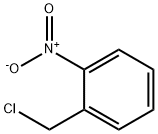2-NITROBENZYL CHLORIDE
- CAS No.
- 612-23-7
- Chemical Name:
- 2-NITROBENZYL CHLORIDE
- Synonyms
- 1-(chloromethyl)-2-nitrobenzene;Benzene, 1-(chloromethyl)-2-nitro-;AKOS BBS-00004020;2-NITROBENZYL CHLORIDE;O-NITROBENZYL CHLORIDE;A-CHLORO-O-NITROTOLUENE;α-chloro-2-nitrotoluene;à-chloro-2-nitrotoluene;2-NitrobenzylChloride98%;2-NitrobenzylChloride>
- CBNumber:
- CB5101344
- Molecular Formula:
- C7H6ClNO2
- Molecular Weight:
- 171.58
- MDL Number:
- MFCD00007185
- MOL File:
- 612-23-7.mol
- MSDS File:
- SDS
| Melting point | 46-48 °C (lit.) |
|---|---|
| Boiling point | 127-133 °C/10 mmHg (lit.) |
| Density | 1,556 g/cm3 |
| refractive index | 1.5557 (estimate) |
| Flash point | >230 °F |
| storage temp. | Store below +30°C. |
| solubility | ethanol: soluble98% |
| form | Crystals, Crystalline Powder or Chunks |
| color | Yellow to tan |
| Water Solubility | Soluble in acetone, alcohol benzene, diethyl ether, and ethanol (98%). Insoluble in water. |
| BRN | 388396 |
| Stability | Stable. Incompatible with bases, moisture, acohols, oxidizing agents, amines. Corrodes steel. |
| CAS DataBase Reference | 612-23-7(CAS DataBase Reference) |
| EWG's Food Scores | 1 |
| FDA UNII | HB8U484NPM |
| EPA Substance Registry System | o-Nitrobenzyl chloride (612-23-7) |
| UNSPSC Code | 12352101 |
| NACRES | NA.22 |
SAFETY
Risk and Safety Statements
| Symbol(GHS) |  GHS07 |
|||||||||
|---|---|---|---|---|---|---|---|---|---|---|
| Signal word | Warning | |||||||||
| Hazard statements | H315-H319-H335 | |||||||||
| Precautionary statements | P261-P264-P271-P280-P302+P352-P305+P351+P338 | |||||||||
| Hazard Codes | C | |||||||||
| Risk Statements | 34-36 | |||||||||
| Safety Statements | 26-36/37/39-45-27 | |||||||||
| RIDADR | UN 3261 8/PG 2 | |||||||||
| WGK Germany | 3 | |||||||||
| RTECS | XS9092000 | |||||||||
| F | 19-21 | |||||||||
| HazardClass | 8 | |||||||||
| PackingGroup | II | |||||||||
| HS Code | 29049090 | |||||||||
| NFPA 704 |
|
2-NITROBENZYL CHLORIDE Chemical Properties,Uses,Production
Chemical Properties
liquid
Uses
2-Nitrobenzyl chloride was used in the synthesis of S-(2-nitrobenzyl)cysteine which was inserted into human erythropoietin. 2-Nitrobenzyl chloride was used to prepare 4,4′-dinitrostillbene.
Uses
2-Nitrobenzyl chloride has been used to introduce the photo labile 2-nitrobenzyl protecting group for the phenolic OH group of tyrosine. It is used as a pharmaceutical intermediate.
General Description
Pale yellow crystals. Insoluble in water. Is thermally unstable.
Air & Water Reactions
Insoluble in water.
Reactivity Profile
A halogenated aromatic nitro compound. Aromatic nitro compounds range from slight to strong oxidizing agents. If mixed with reducing agents, including hydrides, sulfides and nitrides, they may begin a vigorous reaction that culminates in a detonation. The aromatic nitro compounds may explode in the presence of a base such as sodium hydroxide or potassium hydroxide even in the presence of water or organic solvents. The explosive tendencies of aromatic nitro compounds are increased by the presence of multiple nitro groups.
Health Hazard
ACUTE/CHRONIC HAZARDS: Toxic. Lachrymator. Causes irritation on contact. Hazardous decomposition products. Mutagen.
Fire Hazard
2-NITROBENZYL CHLORIDE is combustible.
Biochem/physiol Actions
2-Nitrobenzyl chloride reacts with N-methyldiethanolamine and further reaction of the resulting quaternary diol with thionyl chloride at room temperature yields nitrobenzyl mustard quaternary salts.
2-NITROBENZYL CHLORIDE Preparation Products And Raw materials
612-23-7(2-NITROBENZYL CHLORIDE)Related Search:
1of4





